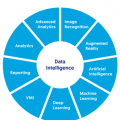- February 21, 2024
- Posted by: SouTech Team
- Category: Others

Introduction
The Evolution of Data Analysis
In the ever-evolving landscape of technology, data analysis has emerged as a transformative force, evolving from its historical roots to become an indispensable tool in shaping the future of business.
Significance in Shaping Business Landscape
The ability to extract meaningful insights from vast datasets is revolutionizing how businesses operate. Data analysis not only informs decision-making but also plays a pivotal role in strategic planning and predictive analytics, positioning it as a driving force in the business world.
The Foundations of Data Analysis
Defining Data Analysis
At its core, data analysis is the process of inspecting, cleaning, transforming, and modeling data to uncover useful information, draw conclusions, and support decision-making.
Historical Context
Data analysis has its roots in statistics, evolving from manual methods to computerized processes. The advent of computers in the mid-20th century marked a significant shift, allowing analysts to process and interpret data more efficiently.
Modern Applications
In the contemporary business landscape, data analysis extends beyond statistical methods. Advanced technologies like artificial intelligence and machine learning have propelled data analysis into new dimensions, offering unprecedented insights and opportunities.
The Impact on Decision-Making
Informed Decision-Making
The primary goal of data analysis is to enable informed decision-making. Businesses rely on data-driven insights to understand market trends, customer behaviors, and internal processes, fostering more effective and strategic decision-making.
Strategic Planning
Data analysis is a cornerstone in strategic planning. By analyzing historical data and forecasting future trends, businesses can develop robust strategies that position them ahead of the competition.
Predictive Analytics
The capacity to anticipate future results is a transformative factor. Predictive analytics, fueled by data analysis, empowers businesses to anticipate market shifts, customer preferences, and potential challenges, allowing proactive responses.
Key Technologies Shaping Data Analysis
Artificial Intelligence
Artificial intelligence (AI) enhances data analysis by automating complex tasks and uncovering patterns that might go unnoticed with traditional methods. AI algorithms can process vast amounts of data rapidly, providing more accurate and timely insights.
Machine Learning
Machine learning algorithms enable systems to learn and improve from experience, making them adept at predicting outcomes and identifying trends. This technology is at the forefront of enhancing the accuracy and efficiency of data analysis.
Big Data Analytics
The era of big data requires sophisticated tools for analysis. Big data analytics allows businesses to extract valuable insights from massive datasets, uncovering hidden patterns and correlations that can inform critical decisions.
Challenges and Opportunities
Overcoming Data Privacy Concerns
With the increased reliance on data, concerns about privacy have risen. The challenge lies in implementing robust security measures while still harnessing the power of data for analysis. Striking this balance presents an ongoing opportunity for innovation.
Harnessing the Power of Unstructured Data
A significant portion of data is unstructured, such as text, images, and videos. Effectively harnessing unstructured data opens new avenues for insights, posing both a challenge and an opportunity for data analysts.
Skill Requirements in the Data-Driven Era
The need for proficient data analysts is on the upward trajectory. Navigating the complexities of data analysis requires a combination of technical proficiency, critical thinking, and adaptability, creating opportunities for those entering the field.
Real-world Examples
Successful Implementation in Industries
Various industries, from healthcare to finance, have successfully implemented data analysis to streamline operations, enhance decision-making, and gain a competitive edge.
Case Studies of Data-Driven Success
Examining specific case studies highlights the tangible impact of data analysis. From optimizing supply chains to improving customer experiences, these examples showcase the real-world benefits of a data-driven approach.
The Future of Data Analysis
Emerging Trends
Exciting opportunities lie ahead in the future of data analysis. Trends such as edge computing, real-time analytics, and augmented analytics are poised to further transform how businesses leverage data.
Integration into Various Sectors
Data analysis is no longer confined to specific industries. Its integration into diverse sectors, including education, agriculture, and transportation, illustrates its universal applicability and potential for positive disruption.
Potential Innovations
Innovations in data analysis are ongoing. As technology evolves, so too will the methods and tools used in data analysis, presenting opportunities for groundbreaking innovations that could redefine the field.
Conclusion
In conclusion, the data analysis revolution is reshaping the business landscape, offering unprecedented opportunities for informed decision-making and strategic planning. From its historical foundations to the integration of cutting-edge technologies, data analysis continues to evolve, presenting challenges and exciting prospects for the future.
FAQs
- How does data analysis contribute to strategic planning?
Data analysis provides insights from historical data and forecasts future trends, empowering businesses to develop robust strategies that position them ahead of the competition.
- What challenges does the data-driven era pose for skill requirements?
The data-driven era demands a combination of technical proficiency, critical thinking, and adaptability, creating opportunities for those entering the field of data analysis.
- How can businesses overcome data privacy concerns while leveraging the power of data?
Overcoming data privacy concerns requires implementing robust security measures while still harnessing the power of data for analysis, striking a delicate balance.
- What industries have successfully implemented data analysis for operational optimization?
Various industries, including healthcare and finance, have successfully implemented data analysis to streamline operations, enhance decision-making, and gain a competitive edge.
- What emerging trends are shaping the future of data analysis?
Emerging trends such as edge computing, real-time analytics, and augmented analytics are poised to further transform how businesses leverage data.





